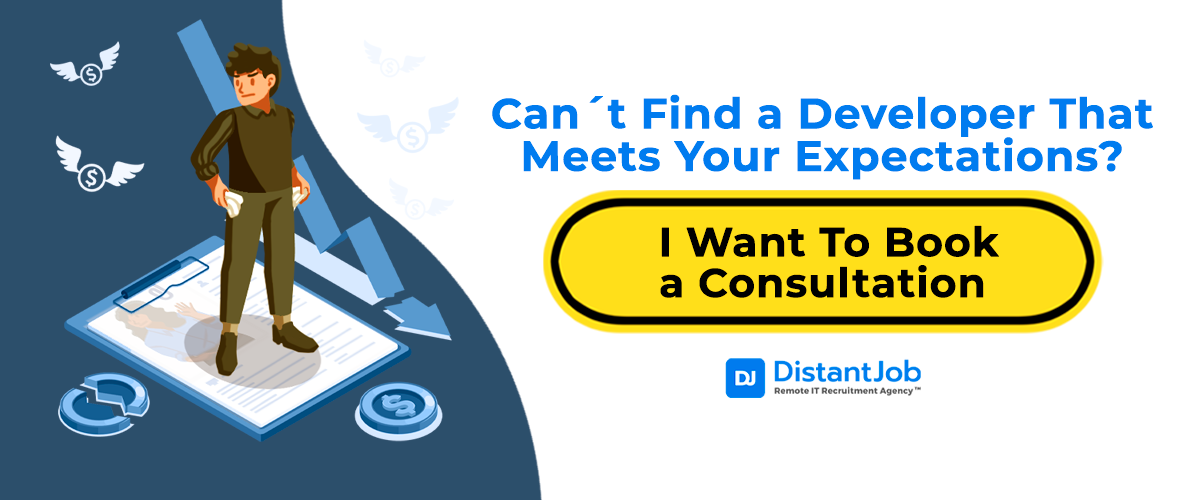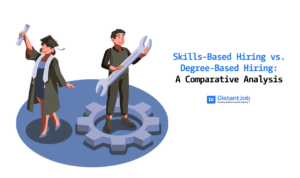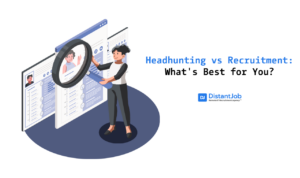Most people underestimate how much a bad hire will cost them and their business. Don’t fall into that trap. Although a fair bit can’t be quantified, there are enough statistics about the cost of a bad hire to give you pause before you rush your next recruitment drive and fall prey to bad hiring decisions.
In this article, we’ll start with a ballpark estimate of the cost of a bad hire in 2024 and then present a formula you can use to get a more precise number for your situation. After that, we’ll discuss the warning signs of a bad hire so you can identify those in your current team and avoid bad hiring decisions. Finally, we’ll give you a few pointers on what to do if the worst has come to pass and you have a wrong fit on your team.
The United States Department of Labor estimates that the cost of a bad hire is at least 30% of the employee’s wages for the first year. So let’s say your new hire has a gross annual income of 60.000 USD; you’re looking at something like a loss of 18.000 USD — in a best-case scenario!
This matches up with a survey run by CareerBuilder. The study found that almost three-quarters of companies with a bad hire reported an average of $14,900 in lost income. Between these employers, 74% simply state they hired the wrong person for the job.
But is that your case? What is the worst-case scenario?
Let’s dive deeper into the causes of a bad hire and explore effective strategies for addressing them. Additionally, we’ll introduce a formula that allows you to input your data and calculate the actual cost of a bad hire in 2024.
Causes of a Bad Hire
Having worked with hundreds of clients over the last few years, we’ve heard much about their regrets. The top 3 reasons that lead people to make bad hiring decisions are:
1. Rushing The Hiring Process
When companies have a sense of urgency to fill a position quickly or to meet tight deadlines, their chances of having a bad hire increase.
When rushed, a lack of thorough evaluation of candidates leads to overlooking critical factors such as skills, qualifications, or cultural fit.
2. Lack Of Experience Interviewing For Both Skillset And Culture Fit
Hiring decisions can go awry when there is a lack of experience in conducting interviews that effectively assess the candidate’s skill set and compatibility with the company’s culture.
Interviewers should be trained in evaluating technical skills, conducting the right types of tests, having job-specific knowledge and experience, as well as assessing how well a candidate aligns with the company’s values, work environment, and team dynamics.
Failing to evaluate both aspects properly can result in hiring someone who may possess the required skills but does not fit well within the organization (or the other way around.)
3. Subpar Or Non-Existing Testing
Making hiring decisions solely based on interviews and resumes without any form of testing or assessment can lead to poor outcomes. Assessments, tests, or practical assignments provide valuable insights into a candidate’s capabilities, problem-solving skills, and how they apply their knowledge in real-world scenarios.
Without proper testing, it becomes challenging to gauge a candidate’s actual competence, which may result in hiring individuals who may not possess the necessary skills or aptitude to perform the job effectively.
How To Avoid Making A Bad Hire
Now that we’ve identified the leading causes of bad hiring decisions, let’s look at how you can improve your hiring process to avoid the cost of a bad hire.
Don’t Think You Have To Hire From The First Batch Of Candidates
Unless you’re working with an IT staffing agency such as DistantJob, where clients routinely hire from the first batch of candidates because we do all the heavy lifting in the background, it’s doubtful that the best people will be among the first to show up.
Take a page from Marie Kondo’s book, and don’t jump on a candidate who doesn’t spark joy! Yes, you are in a rush to hire; your projects are being delayed, and you have deadlines to keep. That’s why we’ve done the math in the previous paragraphs. How does that cost stack up with some delays?
We understand the pressure to settle is considerable when money is on the line. Resist it. The world is big and filled with talented people. The person you need—someone who will love working with you and be a top performer—is out there.
Don’t Judge Them Only For Their Technical Skills
When hiring someone, the first thing you should look for is someone who has a cultural fit with your team. Technical skills are critical, but you can identify the candidate’s baseline pretty quickly with the proper tests, and they can always improve on that baseline once they start.
Culture, though? Either they are a fit from the start, or it’s implausible they will grow into it. That’s why you should commit to the first phase of the interview(s) to learn more about how the candidate behaves, their work habits, and what they care about.
Act as if you are giving them the company tour: explain how everyone in the team likes to work together, what kind of environment you are building, and what kind of expectations you have for your employees. Get them to commit to those expectations and watch their reaction closely.
Above all, try to understand why they are applying. Remember, you want people who are excited about the work they will be doing about the company’s mission. If their reason for applying to your company is to have a remote job, that’s not a good reason!
Test Them For A Month
Once you are reasonably sure that a candidate is a fit, either agree on working together on a paid, time-boxed test project (can be in their free time) or negotiate a trial period in their contract. This might feel a bit unfair to your candidate—who is committing to a new job—but it doesn’t need to be, as long as you are clear about your expectations. If they meet them, they meet them.
Conversely, don’t make this a game. Have them work on a real project with real people, and onboard them as if they’re going to be with you for a decade. It’s on them to bring their best selves to work, but it’s on you to ensure they have everything they need to succeed—while getting a real taste of the company culture and processes.
A trial period is a beautiful thing. It’s a benefit for the new hire and your company; they, too, can figure out if the company is a place where they will be happy. And if the new hire doesn’t match your expectations at the end of the month—congratulations, you just avoided a bad hire!
How To Identify A Bad Hire: 6 Red Flags To Keep In Mind
After you hire someone new—or during the testing period—pay special attention to see if you can spot the following warning signs of bad hires during the onboarding period and also the first month:
- Little attention to quality and standards
- Repeating the same mistakes over and over, no matter how many times colleagues help correct course
- Lacking skills claimed in the CV
- Complaining about work conditions, processes, systems, and/or co-workers
- Inability/unwillingness to take responsibility for projects or mistakes
- Above all, generating complaints from clients and colleagues
This isn’t rocket science, but many people get hung up on “it’s their first month” and “they just need time to learn the ropes.” Those are bad excuses.
Warning Signs Of A Bad Hire During The Interviewing Process
- Candidates showing up for a remote work interview from their cell phone or a noisy location
- Candidates regularly connect through bad connections with poor audio/video
- Poorly written communication. Pre-hiring communication via email or messaging should be clear and concise.
- Focusing too much on the perks and benefits of the job VS the work to be done
- Inability to discuss past work situations (in the absence of an NDA)
- Bad-mouthing past work situation
Yes, you need to be generous with a new hire to some extent, but they should have also committed to some expectations during the hiring process. Hold them accountable to those.
How To Calculate The Cost Of A Bad Hire
According to SHMR, the average cost-per-hire (CPH) is $4.129 in recruitment expenses. Let’s round that to a neat $4.000. We’ve already established a baseline revenue loss equal to 30% of the employee’s income based on the USDL data. So, let’s start with:
CBH = CPH + (employee yearly salary X 0.3)But here is some additional data from the previously-cited CareerBuilder survey. 34% of CFOs said managers have to spend 17% of their time supervising someone who is a bad hire. So let’s update our equation:
CBH = CPH + ((yearly employee salary X 0.3) + (manager monthly salary X duration of employment in months X 0.17)So let’s take the case we outlined above, of a new hire earning $60.000 per year. Let’s assume the average cost-per-hire of $4000 and that their manager makes $90.000 per year or $7500 monthly. Let’s further assume you let the bad hire linger on for three months. In that case, using the formula above, we have:
CBH = 4000 + ((60000 x 0.3) + (7500 x 0.17 x 3)) = 25825Yikes! Over $25,000 dollars down the drain due to a bad hire. How many times can you afford that? Our guess is not a lot. So what to do about it?
As you can see from the equation above, one of the main levers you can pull to reduce the damage is to identify and let go of the bad hire ASAP.
Dealing With a Bad Hire
There is never an easy way to do this. You can set up a couple of evaluation meetings to explain what is missing, although change is rare.
It could be a case that the hire is a good professional but simply not a fit for their current department. It could be worth a shot to move your bad hire to another department where their skills could be more appreciated and/or are a better cultural fit.
If this doesn’t work, taking action is better sooner than later. As a team leader, you can’t waste time hoping someone will have a night epiphany, turning them into the perfect employee. Waiting to make these hard decisions will also impact how your team sees you—and keep upping the multiplier of our “cost of bad hire” equation.
If you know nothing else can be done, you can only be honest and fire your bad hire. We have some tips on how to fire someone right, too.
Conclusion
Good hiring is an art, and following the steps outlined above is not easy; it takes practice and perseverance, and you will stumble no matter how good you are. Luckily, you can shift the risk to a professional outfit. Likes us.
At DistantJob, we are experts in the remote hiring process. To pick the right candidate, we do a deep dive into your company culture and requirements and pay attention to soft skills and attitude during the interview process. We find people who will love working for you. In addition to that, we filter and pre-interview dozens of candidates, so you only see the top 3%, meaning you get the right fit faster and without all the legwork.
There is never an easy way to deal with bad hires or choose the best person for your company. You can learn from experience and listen to your team to improve the different stages of the hiring process… or you can get seasoned pros with over a decade of remote hiring experience to handle it. Contact us to set up a discovery call.




